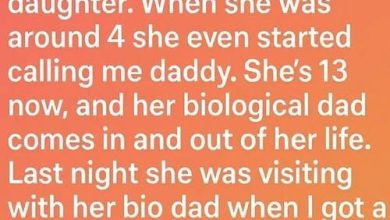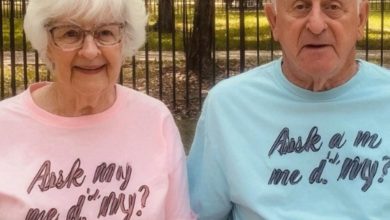
MY DAUGHTER WAS THRILLED TO HOLD HER NEWBORN SISTER, UNTIL SHE WHISPERED ONE WORD THAT SHOOK ME TO MY CORE!
When I first heard about Jaden refusing to remove his hat, I assumed it was a routine dress-code issue. Just another Tuesday morning — coffee cooling on my desk, papers stacked high, the sleepy hum of middle school settling into its day. Then the phone rang.
“Can you come down to my classroom?” the teacher asked, her voice uneasy. “It’s Jaden. He won’t take off his hat. I don’t think this is about the rules.”
I knew Jaden. Quiet. Respectful. The kind of kid who never drew attention. If he was pushing back, something was wrong.
When I entered the classroom, the energy shifted. Conversations faded. Jaden sat alone, shoulders hunched, cap pulled low over his eyes. His hands were clenched in his lap, his body rigid — like he was bracing for something.
“Hey, Jaden,” I said softly. “Want to come with me for a minute?”
He nodded without lifting his head.
In my office, he stayed silent, the hat still on. When he finally spoke, his voice was barely audible. “Please don’t make me take it off.”
I pulled up a chair. “You know the rule,” I said gently. “But if there’s a reason, I’ll listen. I promise.”
He hesitated. His shoulders trembled. Then, in a voice that cracked on the last word, he said, “The kids laughed at me. Said my hair looks stupid. Patchy. Messed up.”
I looked closer. His face was pale, drawn. There was more than embarrassment in his voice — there was shame. And something deeper.
“Jaden,” I said, “if you’re okay with it, I can help. I’ve cut hair before. We can even it out.”
He paused, then gave a small nod.
When I gently lifted the hat, my breath caught. Beneath the uneven patches were faint scars — thin, faded, but unmistakable. They traced his scalp like whispers of pain no child should carry.
I didn’t speak. I just began trimming, slow and careful. The only sound was the soft snip of scissors.
After a while, Jaden spoke again. “My mom’s boyfriend did it,” he said. “He got mad. Said I was talking back. I wasn’t.”
My hand froze.
I’d worked with kids in crisis before, but this was different. This wasn’t defiance. It was survival.
When I found my voice, I said, “I’m so sorry, Jaden. You didn’t deserve that. You never do.”
He didn’t respond — just nodded faintly. When I finished, I handed him a mirror. He studied his reflection for a long time, then gave me the smallest smile. The kind you earn.
The Weeks That Followed
After that day, I made a point to check in. A nod in the hallway. A quiet moment at lunch. I didn’t pry — just made sure he knew someone saw him.
At first, he barely spoke. Then slowly, the walls began to lower. One afternoon, sitting across from me, he asked, “Have you ever been scared to go home?”
The question stopped me cold.
I told him the truth — about my own childhood, about fear that lived in the corners of the night. I told him that fear doesn’t mean weakness. Sometimes it’s your body’s way of saying you still want to live.
He nodded, eyes glistening. Then he whispered one word: “Same.”
That word said everything. The bruises. The silence. The way he clung to that hat. It wasn’t rebellion. It was armor.
I reached out to Miss Raymond, our school counselor. She was calm, steady — the kind of adult kids trust without needing to explain why. She began meeting with Jaden regularly. Slowly, he opened up. He spoke of hiding in his room. Of wishing he could disappear.
The Breaking Point
Weeks later, I was leaving school when I saw him sitting on the front steps. A duffel bag at his feet. A bruise forming under one eye.
“He hit me again,” he said quietly. “I can’t go back.”
I called Miss Raymond. Together, we contacted Child Protective Services. That night, Jaden was placed in temporary housing. It wasn’t perfect. But it was safe.
Before he left, he turned to me and said, “Thanks for not making me take my hat off.”
It was such a simple thing. But I understood. It wasn’t about the rule. It was about dignity. About being seen without being exposed.
The New Beginning
Months passed. Jaden transferred to another school. I kept in touch with his caseworker — heard he was adjusting, making friends, settling in.
Then one spring afternoon, I got a letter.
Inside was a photo of Jaden on a track field, medal around his neck. The note was short, written in careful block letters:
“I made the track team. I’m running faster than I ever have. Miss Raymond said I should write and say thank you for helping me when no one else did. I don’t wear hats much anymore. But I kept that one — just to remind me that sometimes people care.”
I stared at that photo for a long time. His smile was wide. Real. You could see the strength in it.
The Lesson
That day in the classroom wasn’t about a hat. It was about a child carrying a weight too heavy to bear alone.
We live in a world obsessed with discipline. With compliance. With order. But Jaden taught me something deeper: before you ask a child to follow the rules, you have to understand why they’re breaking them.
That hat wasn’t defiance — it was protection.
Those scars weren’t signs of trouble — they were proof of survival.
And that quiet boy who once hid behind a brim learned to stand tall — not because we demanded it, but because we gave him space to heal.
If I learned anything from Jaden, it’s this: sometimes the most powerful thing you can say to a child in pain isn’t “take off your hat.”
It’s “you’re safe now.”
And that truth — that simple, sacred truth — can change everything.




